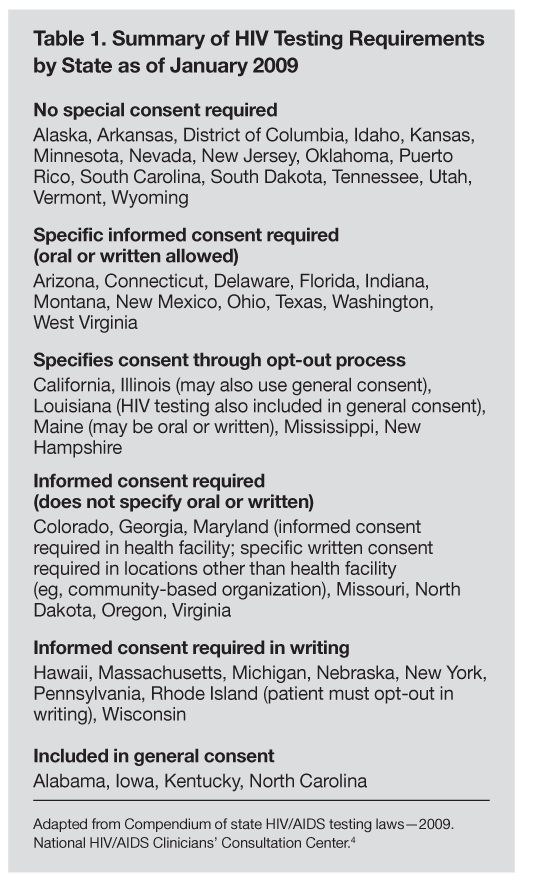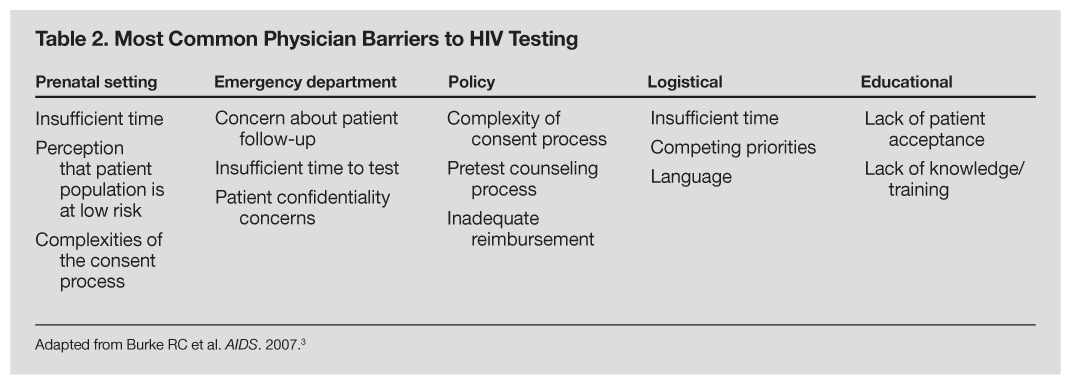- Clinical Technology
- Adult Immunization
- Hepatology
- Pediatric Immunization
- Screening
- Psychiatry
- Allergy
- Women's Health
- Cardiology
- Pediatrics
- Dermatology
- Endocrinology
- Pain Management
- Gastroenterology
- Infectious Disease
- Obesity Medicine
- Rheumatology
- Nephrology
- Neurology
- Pulmonology
Expanding HIV Testing: Overcoming Physician Barriers
In a recent AIDS Reader editorial, Joel E. Gallant called for clinicians who treat persons with HIV/AIDS to “become vocal advocates for routine HIV screening,
In a recent AIDS Reader editorial, Joel E. Gallant called for clinicians who treat persons with HIV/AIDS to “become vocal advocates for routine HIV screening,”1 in line with recent CDC recommendations to screen all patients between the ages of 13 and 64 in US health care settings.2 One of the citations in that editorial was particularly telling: “Why don’t physicians test for HIV?”3
This month’s Managing Managed Care column summarizes the results of the research by Burke and colleagues3 that concluded that US physicians experience “many policy-based, logistical and educational barriers to HIV testing.” Not surprising was their additional conclusion that there was a commonality of some of these barriers across the practice settings studied.
THE PROBLEM
In their review, Burke and colleagues conducted a comprehensive search of the literature, including Internet databases and presentations from major domestic and international HIV-related conferences, and interviewed key researchers to draw their conclusions regarding physicians’ barriers to HIV testing. Some of these interviews involved unpublished data that were also summarized in their final analysis.
Physicians were divided into 3 general areas of practice: prenatal providers, emergency department providers, and other medical providers. In the end, they identified 17 studies that articulated 41 physician barriers to HIV testing.
The common themes across the 3 practice areas are listed below3:
• Insufficient time.
• Consent process complexity.
• Lack of knowledge/training.
• Language.
• Lack of patient acceptance.
• Pretest counseling requirements.
• Competing priorities.
• Inadequate reimbursement.
These 8 themes were not necessarily the most commonly listed barriers in the 3 practice areas but, instead, constitute the core group of barriers identified across all of the surveys identified by the authors.

That the authors identified issues related to the consent process as a problem was not terribly surprising when one considers the wide variation in the HIV consent process among the states, ranging from no specific requirement (15 states and the District of Columbia) to special, written informed consent (8 states) (Table 1).4 Only 6 states specify that opt-out testing, as recommended by the CDC,2 is permissible. Pretest and posttest counseling requirements fall into an equally broad array of categories, and the requirement for one or the other is not necessarily linked to requirements for informed consent.2,4 In other words, some states that do not require informed consent, in fact, have requirements for pretest or posttest counseling.
There were other surprises in this study of physician barriers. Table 2 lists the most common barriers identified in prenatal settings. Obviously, the perception that the patient population was at low risk for HIV infection is in direct conflict with the CDC’s universal testing theme. Additional identified barriers that were unique to the prenatal setting included provider lack of knowledge/training, fear/concern of offending the patient, concern about treating an HIV-positive patient, and pretest counseling requirements.
The most common barriers to HIV testing in emergency departments are summarized in Table 2. In addition to the 3 most common themes listed, emergency department providers also cited pretest counseling requirements, language barriers, and cultural barriers.
In general, the most common barriers cited in other medical settings were similar to those for emergency departments, with the addition of competing patient care requirements and inadequate reimbursement.

Two separate reviews have elaborated further on barriers to opt-out testing and offer a similar set of conclusions.5,6 They discuss concerns in the advocacy community that discontinuing mandatory counseling for high-risk persons who test negative would deprive this population of the benefit of messages to help them remain HIV-negative. They clarify this perception by stating that the CDC’s 2006 testing guidance never recommended abandoning prevention counseling. Instead, the guidance offers the flexibility for clinicians to use their professional judgment regarding the content of this message. Bartlett and colleagues6 also bring a sense of reality into the counseling debate by citing the data that indicate that counseling has “not been shown to consistently reduce the rate of HIV acquisition.”
CREATIVE SOLUTIONS
In an attempt to identify solutions to these barriers, Burke and coworkers3 grouped the common themes into policy barriers, logistical barriers, and educational barriers (Table 2).
While many of the solutions to these barriers are fairly straightforward, it is obvious again, according to the authors, that we are not fully prepared to implement routine HIV testing in medical settings. Certainly, addressing the policy issues with opt-out testing is a high-priority solution for those states that do not allow it. Eliminating, or at least truncating, the requirements for prevention counseling is another solution, since prevention counseling does not provide the safety net that was once anticipated.5 Solutions to logistical barriers include streamlining the consent and counseling requirements and physician use of brief, written fact sheets and scripts when introducing the topic of HIV testing to patients.
While the debate continues, several notable efforts are ongoing to tackle the problem of universal or routine HIV testing. The CDC has been funding pilot programs of HIV testing in emergency departments since 2002,7,8 and guidance is available for emergency departments contemplating such a program.9
In addition, some communities are taking aggressive action with widespread HIV testing. The Bronx-Wide HIV Testing Initiative is probably the most notable example.10 The goal of this initiative is to increase HIV testing so that every Bronx resident learns his or her HIV status and has access to medical care and prevention services. With a wide array of more than 50 community partners, including community health centers, hospitals, and community-based organizations, this ambitious collective effort led by the New York City Department of Health aims to test the estimated 250,000 Bronx residents between the ages of 18 and 64 who do not know their HIV status. Even more remarkable is the fact that the Bronx initiative was given a waiver by the New York State Health Department from New York State’s separate, written consent regulation. Instead, consent for HIV testing has been incorporated into a general consent.
The Bronx initiative, begun in June 2008, has not yet produced or published a status report; the first is due in June 2009. Informal communications with the program’s organizers suggest that the initiative is on track and gaining acceptance, considering the enormity of the undertaking. Whatever the results, this initiative is a breath of public health fresh air that gets straight to the business of addressing routine HIV testing, rather than continuing to debate the issue while people with HIV infection remain unaware of their status.
References:
References1. Gallant JE. Preaching to the choir: advocating routine HIV testing. AIDS Reader. 2009;19:89-90.
2. Centers for Disease Control and Prevention. Revised recommendations for HIV testing of adults, adolescents, and pregnant women in health-care settings. MMWR. 2006;55:1-17.
3. Burke RC, Sepkowitz KA, Bernstein KT, et al. Why don’t physicians test for HIV? A review of US literature. AIDS. 2007;21:1617-1624.
4. Compendium of state HIV/AIDS testing laws-2009. National HIV/AIDS Clinicians’ Consultation Center. http://www.nccc.ucsf.edu/StateLaws/Index.html. Accessed March 30, 2009.
5. Weinhardt LS, Carey MP, Johnson BT, Bickham NL. Effects of HIV counseling and testing on sexual risk behavior: a meta-analytic review of published research, 1985-1997. Am J Public Health. 1999;89:1397-1405.
6. Bartlett JG, Branson BM, Fenton K, et al. Opt-out testing for human immunodeficiency virus in the United States: progress and challenges. JAMA. 2008;300:945-951.
7. Centers for Disease Control and Prevention. Rapid HIV testing in emergency departments-three US sites, January 2005-March 2006. MMWR. 2007;56:597-601. http://www.cdc.gov/mmwr/preview/mmwrhtml/mm5624a2.htm. Accessed March 30, 2009.
8. Fox TG. Hospitals picked to offer free H.I.V. tests. New York Times on line edition. January 2, 2009.
http://www.nytimes.com/2009/01/04/nyregion/connecticut/04hivct.html?_r=1. Accessed March 30, 2009.
9. Health Research & Educational Trust. HIV testing in emergency departments: a practical guide. http://www.edhivtestguide.org. Accessed March 30, 2009.
10. Bronx-Wide HIV Testing Initiative. http://www.nyc.gov/html/doh/html/ah/bronx_test.shtml. Accessed March 30, 2009.
